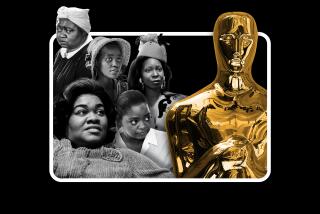Op-Ed: Hollywood’s diversity problem beyond ‘Selma’: Asian, Latino stories are missing
It’s Oscar time, when conversations about racial diversity in Hollywood usually focus on one color: black.
The critically acclaimed historical drama “Selma,” produced by Oprah Winfrey, garnered only two nominations: best picture and best original song. The omission of David Oyelowo, who played Martin Luther King Jr. in “Selma,” among best actor nominees is as glaring as Ava DuVernay’s omission from the best director list. She would have been the first black woman nominated in that category.
That “Selma” was snubbed by the Motion Picture Academy of Arts and Sciences — whose membership is 94% white, 77% male, with a median age of 62, according to a 2012 L.A. Times study — is hard to argue with. But Hollywood’s black problem is only part of the story.
OSCARS 2015: Complete list | Ballot | Cheat Sheet | Top nominees | Presenters | Timeline
The Oscar nominees this year and most years, and the movie industry they represent, fall woefully short when it comes to mirroring American society and, increasingly, the moviegoing audience. And that’s especially true when it comes to the fastest-growing racial group in the nation, Asians, and the largest minority group, Latinos.
According to the latest available demographic study by the Motion Picture Assn. of America, Latinos are Hollywood’s most loyal moviegoers measured against their share of the population. Though Latinos make up only about 17% of the U.S. population, they accounted for 32% of what the MPAA calls “frequent moviegoers” in 2013.
Using data compiled by Nielsen and Univision, TheWrap reported that in 2014 Latinos made up at least 20% of the opening-week audience for the highest-grossing summer movies. As Chris Aronson, Fox’s president of domestic distribution, told TheWrap: “You don’t have a major hit without Hispanic moviegoers.”
Asians, whom the MPAA includes in the category “other,” come in last among frequent moviegoers in simple numbers, but for their population, they outdistanced whites in 2013: “others” made up 8% of the population, according to the MPAA, and 7% of frequent moviegoers. And from a global perspective, their native countries, especially China, are a huge market for Hollywood, which hasn’t gone unnoticed at the studios.
“Transformers: Age of Extinction,” the No. 1 box-office draw in China in 2014, contained Chinese product placements and a Hong Kong action sequence, with roles for Chinese actors. But though he liked the movie, one fan wasn’t taken in by the outreach. “Too many advertisements,” he told the Guardian newspaper. “If they included more content about Chinese families, or Chinese culture, that might be more interesting.”
That essential message — a bigger narrative universe requiring more non-white leads, second leads and ensembles — hasn’t taken hold in major motion pictures. A study by the University of Southern California of the 100 top-grossing films of 2012 found that Latinos are the most underrepresented group on screen, with only 4% of speaking roles, while Asian actors account for 5%, and blacks (approaching their percentage of the population), 11%.
And those statistics don’t begin to address the nature of those roles. When was the last time we saw a Latino hero in a major motion picture? And we’re not talking superhero, just an ordinary hero. When was the last time a mainstream movie portrayed an Asian man as sexy? As far back as Bruce Lee in 1970s? How often are minorities cast simply as the gangbanger, the immigrant or the maid? There are always exceptions but, please, even Jennifer Lopez proves rather than upends the rule.
How about television? This year, Hollywood’s other half has won praise for its risk taking and its diversity. On network, cable or streaming outfits like Netflix, racial diversity means black and more than black. While black actresses such as Viola Davis (ABC’s “How to Get Away With Murder”) and Uzo Abuda (Netflix’s “Orange Is the New Black”) have been collecting awards, hit shows featuring realistic and complex Latino and Asian narratives are gaining steam. ABC’s “Cristela,” starring Cristela Alonzo, and the CW’s “Jane the Virgin,” starring Golden Globe winner Gina Rodriguez, for example. Or ABC’s “Fresh Off the Boat,” based on the life of chef Eddie Huang.
Although TV seems more like the real world, if you dig deeper, its problems are not unlike the movies’. The Ralph J. Bunche Center for African American Studies at UCLA last year released a comprehensive “Hollywood Diversity Report” (the second one comes out Feb. 25). It’s not a pretty picture.
Minorities are underrepresented compared to their numbers in the overall population by a factor of about 3-1 among lead roles in film and among film directors. That ratio is nearly 5-1 when it comes to screenwriters. On TV, minorities do best on cable, where they’re only underrepresented 2-1 among lead actors in dramas and comedies. Among show creators, the discrepancy is nearly 9-1 in broadcast, nearly 5-1 in cable. All this when ratings and box office tend to rise when casts match the nation’s racial and ethnic diversity.
“The decision makers,” the report concluded, “routinely surround themselves with people with whom they feel comfortable — people who think (and often look) like them.” Worse, they peddle the notion that there is a “necessary tradeoff between diversity and excellence” and diversity and box office.
The entertainment industry is a difficult, risky and expensive proposition by any measure. Adding the pressure of achieving racial diversity will, for some, feel forced or cumbersome. It’s more comfortable to rely on those you already know and what you think has worked in the past. But for its very survival, Hollywood has to change, in every color. It will be good for the industry’s bottom line and good for our nation’s collective soul.
Jose Antonio Vargas is the executive editor of #EmergingUS, a new venture with The Times, and the founder of Define American, a media and culture organization. Janet Yang is a film producer whose credits include “The Joy Luck Club.” Yang has been a member of the academy since 2002 and sits on the advisory board of Define American.
Follow the Opinion section on Twitter @latimesopinion and Facebook
More to Read
A cure for the common opinion
Get thought-provoking perspectives with our weekly newsletter.
You may occasionally receive promotional content from the Los Angeles Times.







